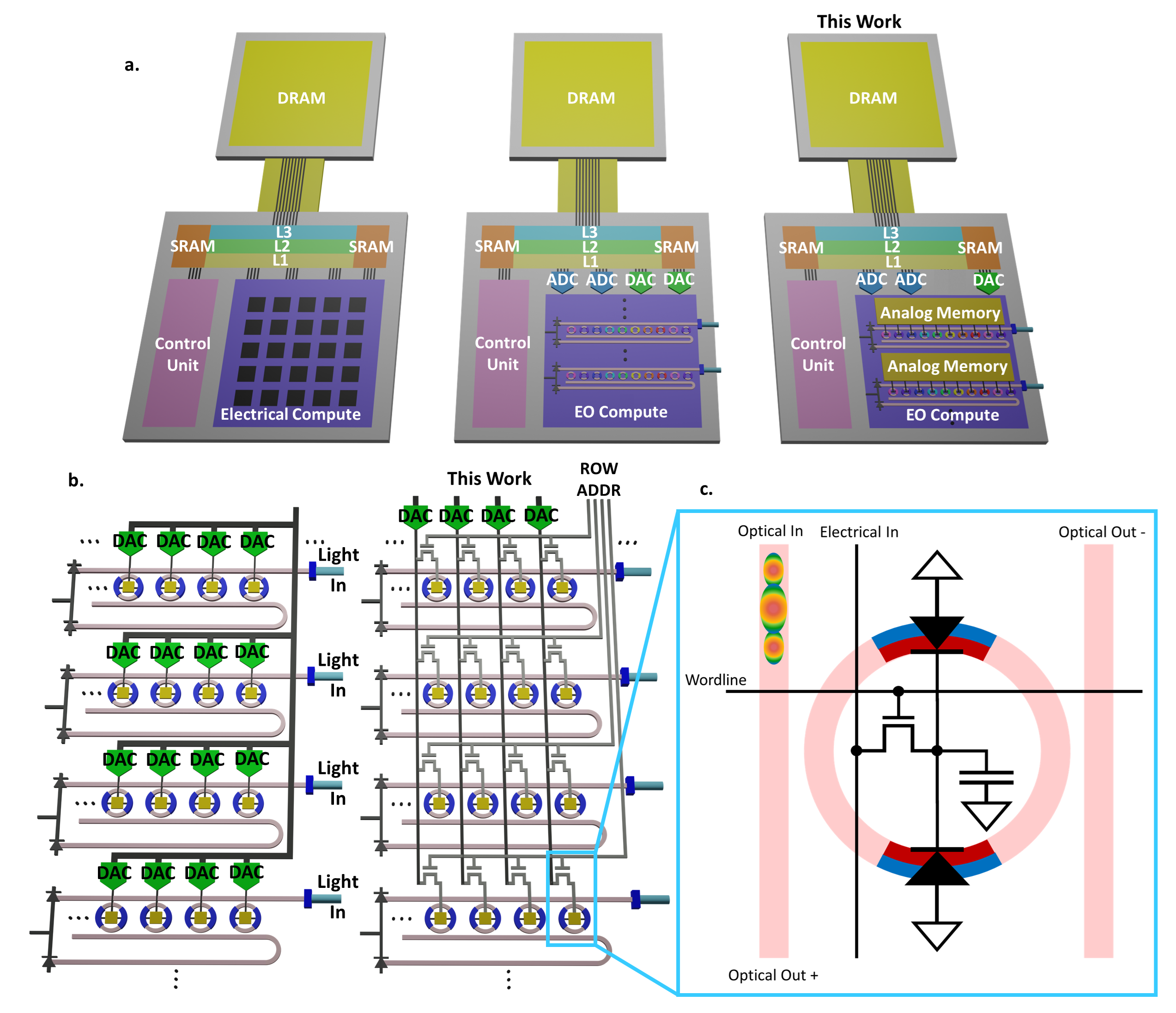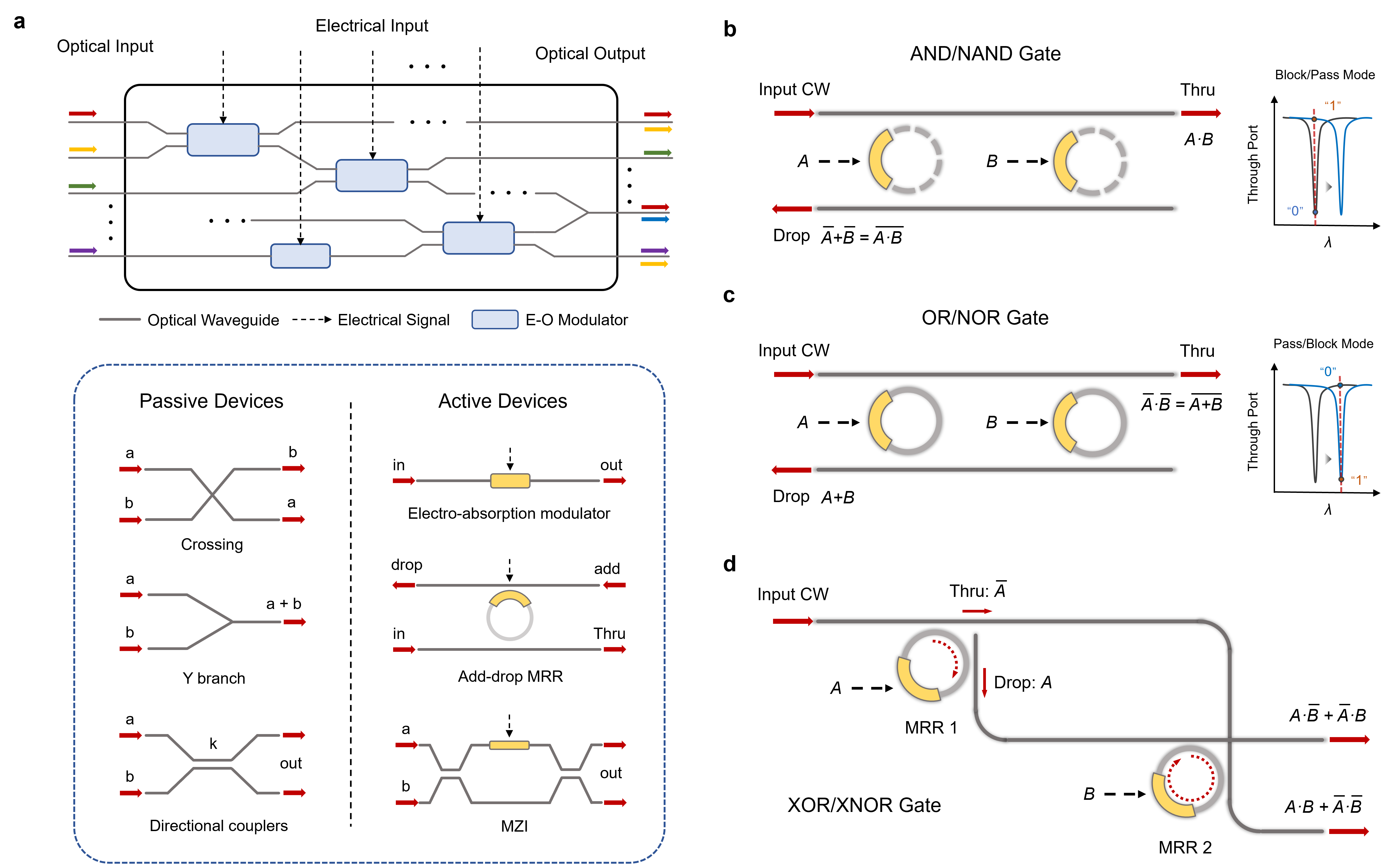Dynamic Electro-Optic Analog Memory for Neuromorphic Photonic Computing

0

Sign in to get full access
Overview
- The paper presents a new type of dynamic electro-optic analog memory for use in neuromorphic photonic computing systems.
- The memory is based on a photonic integrated circuit that can store and recall analog values with high precision and speed.
- The authors demonstrate the memory's capabilities through experiments and simulations, showing its potential for improving the efficiency and performance of neuromorphic computing.
Plain English Explanation
The paper describes a new kind of memory system that could be used in a special type of computer called a "neuromorphic" computer. Neuromorphic computing is inspired by how the human brain works, using analog signals and interconnected components instead of the digital ones and logic gates found in traditional computers.
The memory system in this paper is based on photonic integrated circuits - tiny chips that use light instead of electricity to process information. The memory can store and recall analog values, meaning it can remember not just 0s and 1s, but a continuum of values in between. This gives it the ability to represent information more like the brain does.
The authors show through experiments and simulations that this electro-optic analog memory can store and retrieve data very quickly and accurately. This could make neuromorphic computers that use this memory more efficient and powerful than current designs. For example, it could allow them to perform certain tasks like image recognition or decision-making much faster and with less power.
Technical Explanation
The core of the paper is the design and demonstration of a dynamic electro-optic analog memory integrated onto a photonic chip. The memory is based on a Mach-Zehnder interferometer, which uses the interference of light waves to modulate an optical signal and store analog values.
The authors describe the detailed architecture of the memory, including the optical and electrical components that allow it to write, store, and read analog values. Through experimental results and simulations, they show the memory can store and recall values with high precision (less than 1% error) and at high speeds (up to 10 GHz).
Additionally, the authors integrate this analog memory into a neuromorphic photonic computing system and demonstrate its use for performing neuromorphic computing tasks like pattern recognition. They show how the analog memory can improve the efficiency and performance of these neuromorphic systems compared to digital memory.
Critical Analysis
The paper presents a compelling new memory technology that could advance the field of neuromorphic computing. The ability to store and manipulate analog values at high speeds is a key requirement for building brain-inspired computing systems that can match the human brain's remarkable information processing capabilities.
That said, the authors acknowledge several limitations and areas for future work. For example, the current memory design has a fairly small storage capacity, and the optical components required may introduce additional complexity and cost. Further research is needed to scale up the memory size and integrate it more seamlessly into complete neuromorphic photonic systems.
Additionally, the paper focuses primarily on the technical characteristics of the memory itself, without delving deeply into the implications for real-world applications. More work is needed to understand how this type of analog memory could be leveraged to solve practical problems in areas like machine learning, robotics, or sensor processing.
Overall, this research represents an important step forward in the development of neuromorphic computing hardware. By continuing to advance analog memory and other key components, the field may ultimately realize the dream of creating computers that can rival the brain's flexibility, efficiency, and problem-solving abilities.
Conclusion
This paper introduces a novel dynamic electro-optic analog memory that could significantly enhance the performance of neuromorphic photonic computing systems. The memory's ability to store and recall analog values with high precision and speed addresses a key challenge in building brain-inspired computers.
While further research is needed to scale up the memory and integrate it into complete neuromorphic systems, this work represents an important advance that could help bring us closer to realizing the potential of neuromorphic computing. By bridging the gap between the brain's analog information processing and the digital nature of conventional computers, this type of analog memory could unlock new frontiers in artificial intelligence, robotics, and other technology domains.
This summary was produced with help from an AI and may contain inaccuracies - check out the links to read the original source documents!
Related Papers


0
Dynamic Electro-Optic Analog Memory for Neuromorphic Photonic Computing
Sean Lam, Ahmed Khaled, Simon Bilodeau, Bicky A. Marquez, Paul R. Prucnal, Lukas Chrostowski, Bhavin J. Shastri, Sudip Shekhar
Artificial intelligence (AI) has seen remarkable advancements across various domains, including natural language processing, computer vision, autonomous vehicles, and biology. However, the rapid expansion of AI technologies has escalated the demand for more powerful computing resources. As digital computing approaches fundamental limits, neuromorphic photonics emerges as a promising platform to complement existing digital systems. In neuromorphic photonic computing, photonic devices are controlled using analog signals. This necessitates the use of digital-to-analog converters (DAC) and analog-to-digital converters (ADC) for interfacing with these devices during inference and training. However, data movement between memory and these converters in conventional von Neumann computing architectures consumes energy. To address this, analog memory co-located with photonic computing devices is proposed. This approach aims to reduce the reliance on DACs and ADCs and minimize data movement to enhance compute efficiency. This paper demonstrates a monolithically integrated neuromorphic photonic circuit with co-located capacitive analog memory and compares various analog memory technologies for neuromorphic photonic computing using the MNIST dataset as a benchmark.
Read more9/12/2024


0
Photonic-Electronic Integrated Circuits for High-Performance Computing and AI Accelerators
Shupeng Ning, Hanqing Zhu, Chenghao Feng, Jiaqi Gu, Zhixing Jiang, Zhoufeng Ying, Jason Midkiff, Sourabh Jain, May H. Hlaing, David Z. Pan, Ray T. Chen
In recent decades, the demand for computational power has surged, particularly with the rapid expansion of artificial intelligence (AI). As we navigate the post-Moore's law era, the limitations of traditional electrical digital computing, including process bottlenecks and power consumption issues, are propelling the search for alternative computing paradigms. Among various emerging technologies, integrated photonics stands out as a promising solution for next-generation high-performance computing, thanks to the inherent advantages of light, such as low latency, high bandwidth, and unique multiplexing techniques. Furthermore, the progress in photonic integrated circuits (PICs), which are equipped with abundant photoelectronic components, positions photonic-electronic integrated circuits as a viable solution for high-performance computing and hardware AI accelerators. In this review, we survey recent advancements in both PIC-based digital and analog computing for AI, exploring the principal benefits and obstacles of implementation. Additionally, we propose a comprehensive analysis of photonic AI from the perspectives of hardware implementation, accelerator architecture, and software-hardware co-design. In the end, acknowledging the existing challenges, we underscore potential strategies for overcoming these issues and offer insights into the future drivers for optical computing.
Read more7/15/2024
🧠

0
A Pipelined Memristive Neural Network Analog-to-Digital Converter
Loai Danial, Kanishka Sharma, Shahar Kvatinsky
With the advent of high-speed, high-precision, and low-power mixed-signal systems, there is an ever-growing demand for accurate, fast, and energy-efficient analog-to-digital (ADCs) and digital-to-analog converters (DACs). Unfortunately, with the downscaling of CMOS technology, modern ADCs trade off speed, power and accuracy. Recently, memristive neuromorphic architectures of four-bit ADC/DAC have been proposed. Such converters can be trained in real-time using machine learning algorithms, to break through the speedpower-accuracy trade-off while optimizing the conversion performance for different applications. However, scaling such architectures above four bits is challenging. This paper proposes a scalable and modular neural network ADC architecture based on a pipeline of four-bit converters, preserving their inherent advantages in application reconfiguration, mismatch selfcalibration, noise tolerance, and power optimization, while approaching higher resolution and throughput in penalty of latency. SPICE evaluation shows that an 8-bit pipelined ADC achieves 0.18 LSB INL, 0.20 LSB DNL, 7.6 ENOB, and 0.97 fJ/conv FOM. This work presents a significant step towards the realization of large-scale neuromorphic data converters.
Read more6/5/2024
🐍

0
Towards Reverse-Engineering the Brain: Brain-Derived Neuromorphic Computing Approach with Photonic, Electronic, and Ionic Dynamicity in 3D integrated circuits
S. J. Ben Yoo, Luis El-Srouji, Suman Datta, Shimeng Yu, Jean Anne Incorvia, Alberto Salleo, Volker Sorger, Juejun Hu, Lionel C Kimerling, Kristofer Bouchard, Joy Geng, Rishidev Chaudhuri, Charan Ranganath, Randall O'Reilly
The human brain has immense learning capabilities at extreme energy efficiencies and scale that no artificial system has been able to match. For decades, reverse engineering the brain has been one of the top priorities of science and technology research. Despite numerous efforts, conventional electronics-based methods have failed to match the scalability, energy efficiency, and self-supervised learning capabilities of the human brain. On the other hand, very recent progress in the development of new generations of photonic and electronic memristive materials, device technologies, and 3D electronic-photonic integrated circuits (3D EPIC ) promise to realize new brain-derived neuromorphic systems with comparable connectivity, density, energy-efficiency, and scalability. When combined with bio-realistic learning algorithms and architectures, it may be possible to realize an 'artificial brain' prototype with general self-learning capabilities. This paper argues the possibility of reverse-engineering the brain through architecting a prototype of a brain-derived neuromorphic computing system consisting of artificial electronic, ionic, photonic materials, devices, and circuits with dynamicity resembling the bio-plausible molecular, neuro/synaptic, neuro-circuit, and multi-structural hierarchical macro-circuits of the brain based on well-tested computational models. We further argue the importance of bio-plausible local learning algorithms applicable to the neuromorphic computing system that capture the flexible and adaptive unsupervised and self-supervised learning mechanisms central to human intelligence. Most importantly, we emphasize that the unique capabilities in brain-derived neuromorphic computing prototype systems will enable us to understand links between specific neuronal and network-level properties with system-level functioning and behavior.
Read more4/1/2024